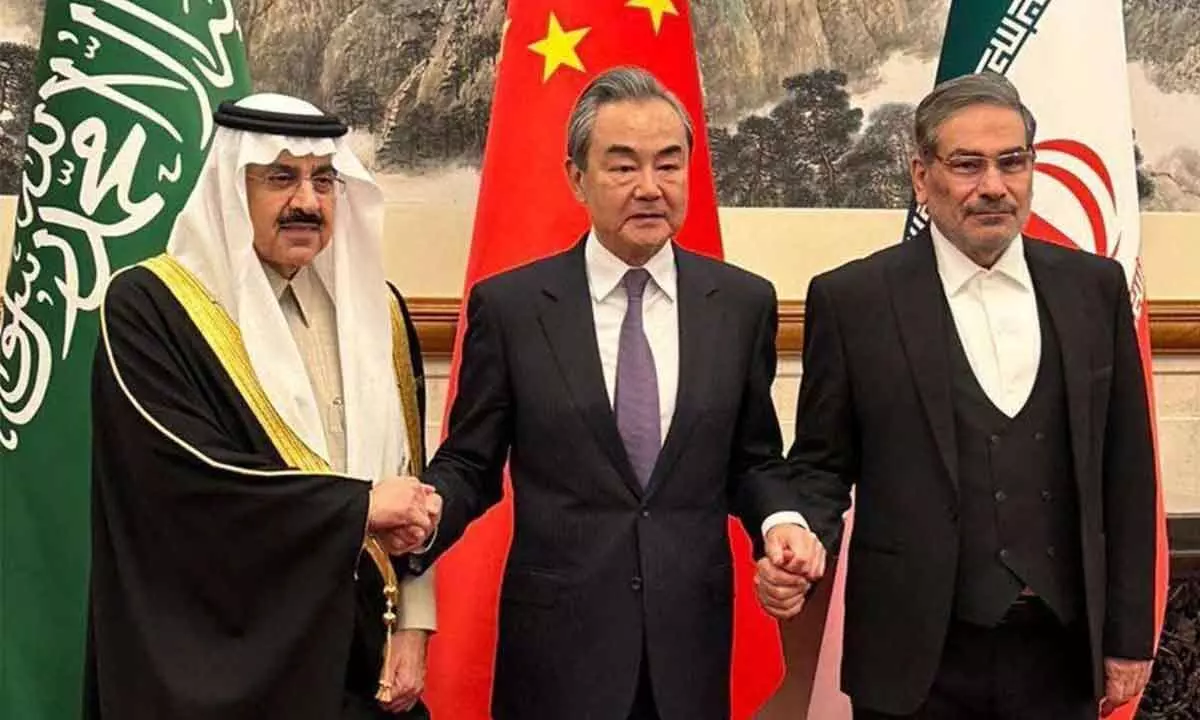Key takeaway from Saudi-Iran pact

The Saudi deal with Iran and choice of China as an intermediary is consistent with a deeper shift in Saudi foreign policy, which has been evident for some time. By adapting to changing circumstances, Mohammed bin Salman is looking to Saudi Arabia’s future and trying to strike a wider balance of power in what he sees as an eventual “post-American” Gulf
The fact that Saudi Arabia entered a rapprochement deal with Iran and chose China to broker it came as a surprise to many international observers. The agreement, officially called the Joint Trilateral Statement, was signed in Beijing on March 11 and begins the process of restoring diplomatic ties between Riyadh and Tehran. Those ties were severed in January 2016 after protesters stormed the Saudi Embassy in Iran in the aftermath of the execution of Nimr al-Nimr, a prominent Saudi Shiite cleric who had criticised Saudi treatment of its Shiite minority.
Saudis question US partnership
The relationship between the US and Saudi Arabia is often said to revolve around an oil-for-security dynamic in which the Saudis provide the former and the US the latter. In reality, ties have spanned a far wider spectrum than that and have been more complicated, with periods of high tension – stemming from events such as Saudi participation in the Arab oil embargo in 1973, or the involvement of Saudi citizens in the Sept. 11 terrorism attacks in 2001. But since the Arab Spring protests in the early 2010s, US-Saudi relations have frayed, both in Riyadh and in Washington.
The perception among Gulf leaders that the Obama administration abandoned former Egyptian President Hosni Mubarak during the Egyptian revolution in 2011 left them deeply rattled. They feared that the US could abandon them just as it had done Mubarak, a longtime partner of 30 years. This was compounded by the Gulf states' exclusion from US negotiations with Iran.
And then in 2019, a missile and drone attack on Saudi oil infrastructure temporarily knocked out half the kingdom's production. The attacks were linked, but never formally attributed, to Iran. President Donald Trump responded by declaring it had been an attack on Saudi Arabia, not on the US, drawing a distinction between their interests. Trump's remarks, and subsequent inaction, caused shockwaves in Riyadh and other Gulf capitals as leaders began to question US credibility as a reliable regional partner. Finally, in 2021, the chaotic nature of the US withdrawal from Kabul, Afghanistan, served to reinforce deeply-rooted perceptions about US disengagement from the Middle East, irrespective of the situation in reality. Saudi Arabia began to broaden its international relationships, with particular attention on China. In a further sign of deepening bilateral ties, in December 2022, Chinese President Xi Jinping visited Saudi Arabia to sign investment agreements across 34 sectors, ranging from green energy and information technology to construction and logistics.
Reconciliation with Iran
Meanwhile, the Saudi outreach to Iran has been more than three years in the making. It began after the 2019 oil attacks and focused initially on de-escalating regional tensions. Saudi and Iranian officials held five rounds of dialogue in Iraq between 2020 and 2022 to try to bridge the issues that divided them. These meetings formed the backdrop to the China-brokered deal in Beijing. Reports have suggested that Saudi Arabia's King Salman has invited Iranian President Ebrahim Raisi to the kingdom, possibly during Ramadan, the Muslim holy month that began on March 22. Any such visit would indicate a political will on both sides to move beyond the two decades of rancour and acrimony that followed the US invasion of Iraq in 2003 and doomed an earlier phase of Saudi-Iranian rapprochement at the turn of the century.
Balancing act on Ukraine
Saudi Arabia's unwillingness to take sides in great power competition is also evident in policy responses to Russia's invasion of Ukraine. One manifestation of this balancing act has been the Saudi decision to work with Russia within the framework of the oil producers group OPEC+ – and at the same time engage with US officials over issues of oil output and prices. The Saudi deal with Iran and choice of China as an intermediary is consistent with a deeper shift in Saudi foreign policy, which has been evident for some time. By adapting to changing circumstances, Mohammed bin Salman is looking to Saudi Arabia's future and trying to strike a wider balance of power in what he sees as an eventual "post-American" Gulf.
- Kristian Coates Ulrichsen
(The Conversation; Writer is Baker Institute Fellow for Kuwait, Rice University, Houston)

















